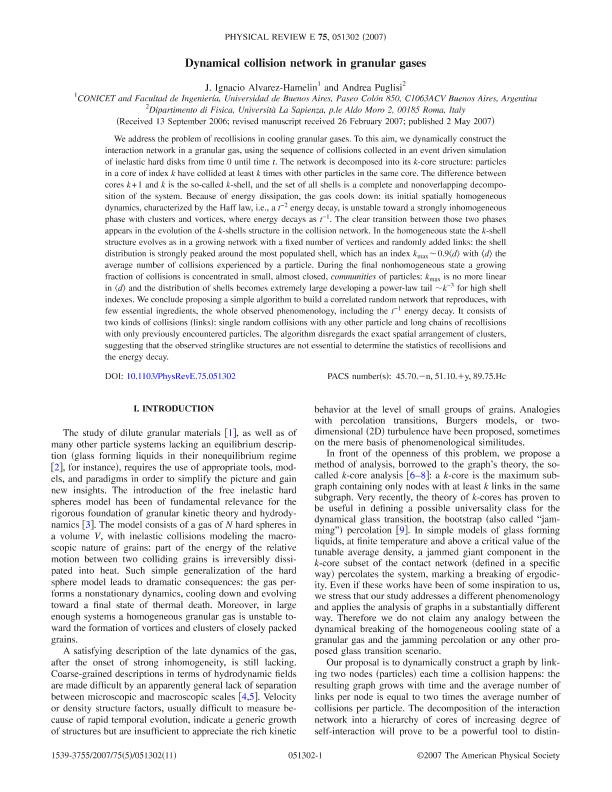Mostrar el registro sencillo del ítem
dc.contributor.author
Alvarez Hamelin, José Ignacio

dc.contributor.author
Puglisi, Andrea
dc.date.available
2017-07-11T17:00:59Z
dc.date.issued
2007-05
dc.identifier.citation
Alvarez Hamelin, José Ignacio; Puglisi, Andrea; The dynamical collision network in granular gases; American Physical Society; Physical Review E: covering statistical, nonlinear, biological, and soft matter physics; 75; 5; 5-2007; 5130201-5130211
dc.identifier.issn
2470-0045
dc.identifier.uri
http://hdl.handle.net/11336/20122
dc.description.abstract
We address the problem of recollisions in cooling granular gases. To this aim, we dynamically construct the interaction network in a granular gas, using the sequence of collisions collected in an event driven simulation of inelastic hard disks from time
0
until time
t
. The network is decomposed into its
k
-core structure: particles in a core of index
k
have collided at least
k
times with other particles in the same core. The difference between cores
k
+
1
and
k
is the so-called
k
-shell, and the set of all shells is a complete and nonoverlapping decomposition of the system. Because of energy dissipation, the gas cools down: its initial spatially homogeneous dynamics, characterized by the Haff law, i.e., a
t
−
2
energy decay, is unstable toward a strongly inhomogeneous phase with clusters and vortices, where energy decays as
t
−
1
. The clear transition between those two phases appears in the evolution of the
k
-shells structure in the collision network. In the homogeneous state the
k
-shell structure evolves as in a growing network with a fixed number of vertices and randomly added links: the shell distribution is strongly peaked around the most populated shell, which has an index
k
max
∼
0.9
⟨
d
⟩
with
⟨
d
⟩
the average number of collisions experienced by a particle. During the final nonhomogeneous state a growing fraction of collisions is concentrated in small, almost closed, communities of particles:
k
max
is no more linear in
⟨
d
⟩
and the distribution of shells becomes extremely large developing a power-law tail
∼
k
−
3
for high shell indexes. We conclude proposing a simple algorithm to build a correlated random network that reproduces, with few essential ingredients, the whole observed phenomenology, including the
t
−
1
energy decay. It consists of two kinds of collisions (links): single random collisions with any other particle and long chains of recollisions with only previously encountered particles. The algorithm disregards the exact spatial arrangement of clusters, suggesting that the observed stringlike structures are not essential to determine the statistics of recollisions and the energy decay.
dc.format
application/pdf
dc.language.iso
eng
dc.publisher
American Physical Society

dc.rights
info:eu-repo/semantics/openAccess
dc.rights.uri
https://creativecommons.org/licenses/by-nc-sa/2.5/ar/
dc.subject
Granular
dc.subject
Networks
dc.subject
Statistic
dc.subject.classification
Telecomunicaciones

dc.subject.classification
Ingeniería Eléctrica, Ingeniería Electrónica e Ingeniería de la Información

dc.subject.classification
INGENIERÍAS Y TECNOLOGÍAS

dc.title
The dynamical collision network in granular gases
dc.type
info:eu-repo/semantics/article
dc.type
info:ar-repo/semantics/artículo
dc.type
info:eu-repo/semantics/publishedVersion
dc.date.updated
2017-07-10T14:53:20Z
dc.identifier.eissn
2470-0053
dc.journal.volume
75
dc.journal.number
5
dc.journal.pagination
5130201-5130211
dc.journal.pais
Estados Unidos

dc.journal.ciudad
Nueva York
dc.description.fil
Fil: Alvarez Hamelin, José Ignacio. Consejo Nacional de Investigaciones Científicas y Técnicas; Argentina. Universidad de Buenos Aires. Facultad de Ingeniería; Argentina
dc.description.fil
Fil: Puglisi, Andrea. Università La Sapienza. Dipartimento di Fisica; Italia
dc.journal.title
Physical Review E: covering statistical, nonlinear, biological, and soft matter physics
dc.relation.alternativeid
info:eu-repo/semantics/altIdentifier/doi/http://dx.doi.org/10.1103/PhysRevE.75.051302
dc.relation.alternativeid
info:eu-repo/semantics/altIdentifier/url/https://journals.aps.org/pre/abstract/10.1103/PhysRevE.75.051302
Archivos asociados
